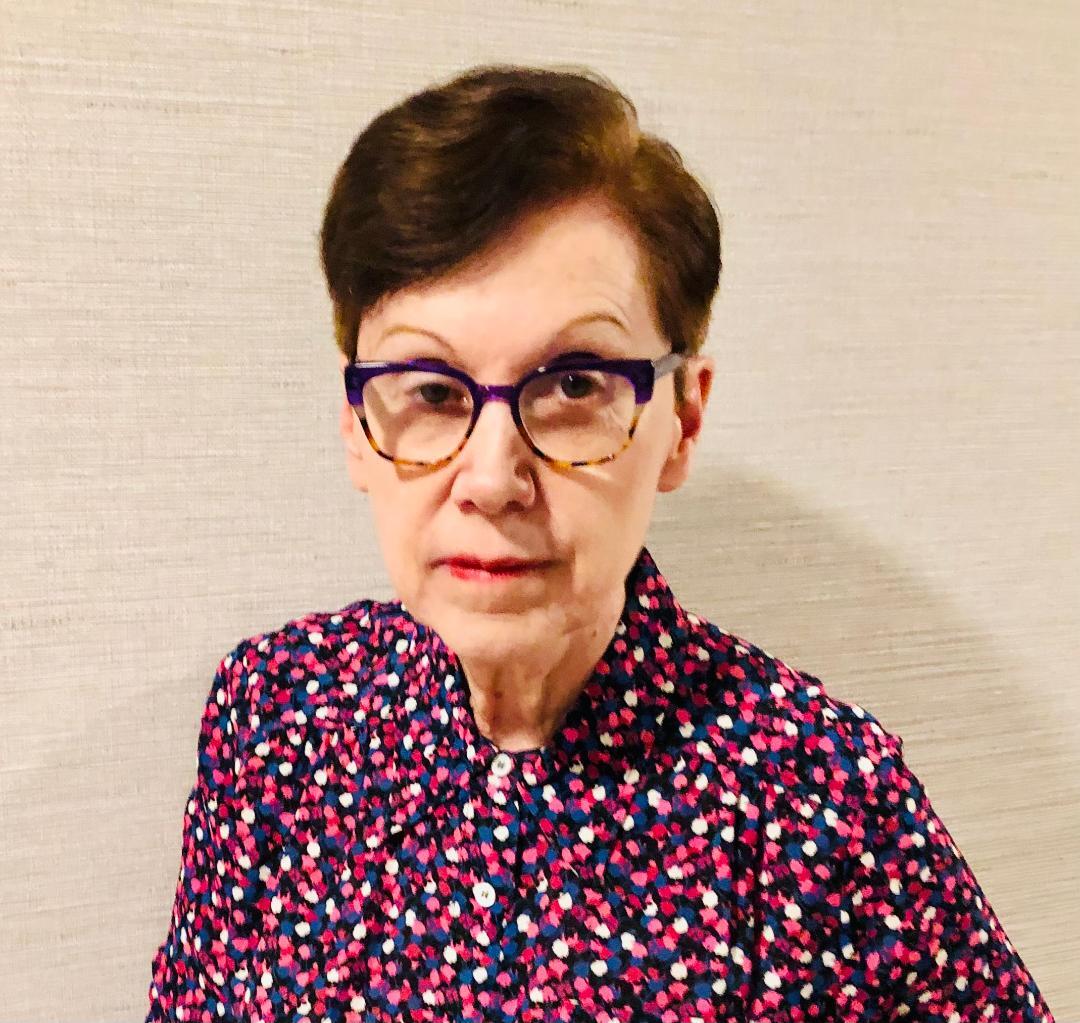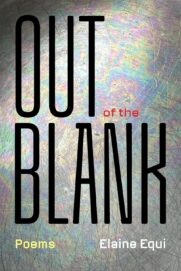
by Jim Feast
A mainstay of the New York literary scene since the late 1980s, Elaine Equi is known as a writer of aphoristic wit, philosophical depth, and visual precision. Her many books include Voice-Over (1999), which won the San Francisco State Poetry Award; Ripple Effect: New & Selected Poems (2007), which was a finalist for the L.A. Times Book Award and shortlisted for the Griffin Poetry Prize; and Sentences and Rain (2015), all published by Coffee House Press. Her work has appeared in numerous journals including American Poetry Review, The Nation, The New Yorker, and in many editions of The Best American Poetry, for which she served as guest editor in 2023. In 2024, she received a Guggenheim Fellowship.
Equi has always been fascinated by how the consumer products we live among form ties with the self. In The Intangibles (Coffee House Press, 2019), for example, discussing her mother’s scent bottles in “Perfume Dioramas,” she links family memories to these store-bought items, deepening both. In Equi’s latest book, Out of the Blank (Coffee House Press, $18), her fascination continues, but here the products are more often connected to fantasies—as in “Maple,” where observation of a bottle of syrup leads to a vivid daydream of vampires. Few other writers have so gleefully and trenchantly examined the commodification of everyday life.
Jim Feast: In poetry, the notion that we should appreciate the simple things in life has become something of a cliché, but you take this theme in new directions, working at times straightforwardly and at others ironically. In “I Saw Delight,” for example, you describe walking after a rain shower with extraordinary precision: “The shadows were dark and luxurious / beneath silver trestles of light.” My sense is that you put great pressure on words to capture the everyday, using terms that are suitable yet never expected. Does that sound true?
Elaine Equi: I’m happy you started with this poem, because it’s an unusual one. It’s true I often do write about mundane things and everyday life, but I think of this particular piece as being the record of a real vision—a true moment of illumination. It came about as the result of my drinking a cocktail made from several different gem elixirs designed to increase the flow of light into your body and energy field. Gem elixirs are small bottles of water or alcohol in which different stones or flowers have been steeped in order to charge them with their essence. You can buy them online or in some health food stores. I’m not an expert by any means, but the idea of them appeals to my imagination. Their effects on me are usually subtle, but on this occasion, they were quite dramatic—almost psychedelic. When I stepped outside my front door, I swear I could see light traveling. As I say in the poem,
I saw a woman carrying the trophy of a gold balloon,
letting it bounce lightly above her head—
her thoughts golden.Someone else was walking a diamond dog.
Each of its hairs was polished to perfection.From every object, prisms of paths opened.
I was ecstatic. Of course, when I tried the experiment again, it wasn’t the same—not even close. The title “I Saw Delight” is a one-line poem by Robert Creeley called “Homage to Hank Williams,” a play on Williams’s famous spiritual song “I Saw the Light.”
JF: Another way you handle the quotidian is to mention one of life’s small pleasures and then use it as a springboard into magnificent whimsy. An example is “Maple,” which begins with a deft description of “its high-pitched sweetness,” but then segues into a lurid territory where in a dream vision you are swigging syrup, saying, “I am drinking the blood of the forest.” Can you talk about creating these flights of fancy?
EE: I’m often influenced by writers of short prose works that have a dark, fantastic, or satiric side. Baudelaire’s Paris Spleen is tattooed on my heart. I’ve taught and read it many times. I’m also thinking here of Kafka’s short stories and aphorisms, and Robert Walser’s quirky sketches. From all the above, I’ve studied the art of making absurd statements with a straight face and matter of fact tone. In the poem you mention, I found it funny to treat maple syrup as a dangerous substance. I was exaggerating but not all that much; I do find maple hard to resist. Plus, I like the idea of using its sweetness to mask a hidden wild or aggressive nature.
JF: Both these strategies of dealing with the everyday could be considered labors that bring poetry closer to the real. Alain Badiou says that to reach the real, “there is an art of rarefaction, an art of obtaining the subtlest and most durable results, not through an aggressive posture with regard to inherited forms, but through arrangements that place these forms at the edge of the void, in a network of cuts and disappearances.”[i] Could you talk about your approach to the real?
EE: That’s an interesting quote by Badiou. I don’t think I come close to “the edge of the void” in my poems. I do try to use very precise and vivid language, and often focus intensely on a simple subject, maybe to create a sense of the hyper-real. One of the things I like about photography is how it shows you a very different aspect of what you think you’re seeing. I’m also a fan of the sur-real, a reality that encompasses dreams, the irrational, the unconscious. Is there just one “real” with different levels? I’m not sure, but I think that as a writer, whether you’re committed to absolute realism or pure fantasy, the real is something you can’t avoid. You can use language to explore and engage with it, but I don’t know that you can ever come close to actually describing or representing it, even in purely mathematical terms. It’s bigger than that. When I write, I feel, or perhaps imagine, that I can sense the real as a kind of gravity or pull. It’s the page beneath the page.
JF: Your ability to discern effervescent qualities of ordinary reality is often used to examine slight objects to which most people would offer little attention. In your previous collection The Intangibles (Coffee House Press, 2019), poems such as “Monogrammed Aspirin” and “Still Life with Radish” did this too. Can you discuss your communion with things?
EE: Objects have always been one of my favorite subjects. When I first began writing, I was an avid reader of the French poet Francis Ponge. He wrote almost exclusively about objects. He had a book called Things and another one called More Things, and another called Soap, which was all about soap. As a tribute to him, I named one of my early chapbooks Friendship with Things. I also had a full-length collection inspired by his work, called The Cloud of Knowable Things (Coffee House Press, 2003).
Not surprisingly, I was also a fan of William Carlos Williams—and of all the Objectivist poets. They gave me a way to think of the poem itself as an object—“a small machine made of words”—and to see words themselves as objects.
We’re now so used to digital and virtual realities that real things seem a bit dated. As I say in the poem you mention from my previous book, “These days, all objects are antiques.” In my new book, I was pleased to find a way to write about mental states as if they were objects—I don’t know why it didn’t occur to me sooner. In the poem “Emotions: A Boxed Set,” for example, I write about the heebie-jeebies as “the kind of tail-in-socket anxiety / that plugs directly into the body— / manifesting in myriad symptoms of dis-ease.”
JF: When you were going to school and growing up as a poet, Chicago had a bustling and distinctive poetry/arts scene. How did that milieu influence your work?
EE: I can’t think of anywhere I’d rather have studied poetry than Columbia College in Chicago—it was a fun, loose, and creative place in the ’70s. It had an excellent film and photography department, and in creative writing, they had just hired an exciting poet, Paul Hoover, to replace Bill Knott. Paul and his then wife, Maxine Chernoff, edited a very cool magazine called Oink! They knew everybody and were really plugged into contemporary poetics from the New York School, the Beats, Black Mountain, fresh takes on surrealism, and beyond. I was in heaven. Every semester I’d sign up for an independent study with Paul just so I could hang out with him and Maxine in their Rogers Park apartment, peruse their bookshelves, and discuss goings on in the poetry world.
Shortly after graduating, I met up with another young poet, Jerome Sala, known for reciting his work to growing numbers of enthusiastic fans in a punk bar called La Mere Viper. By then, I had published my first chapbook, Federal Woman. We each had a glimmer of reputation and the desire to do something out of the ordinary (maybe a tad more flamboyant) with our writing, so we started reading together, mostly in bars and art galleries. It didn’t hurt that we were wildly attracted to each other, too. We had good chemistry off stage and on. Our events were more like parties; sometimes they involved bands, and people you wouldn’t necessarily think would enjoy poetry would show up. You could call us performance poets—we did perform our poems, but we were also performing the idea of poet-ness, often in a satiric way, inventing our identities as we went along. Everything we did had a DIY quality. We’d spend hours combing thrift stores for just the right retro fashions. What I remember most is that the arts were not so separate then—there was much more overlapping between different scenes. Partly it was the times, but it was also something Jerome and I cultivated by exploring the idea of a poetry that could be entertaining and appeal to non-poets.
JF: Earlier you mentioned trying “elixirs designed to increase the flow of light into your body.” This ties in with the poem “My Mother And I Send Each Other Circles,” where we learn that when your speaker talks on the phone with mother, “We telepathically juggle globes of color.” Both seem like nurturing forms of practice, but I wonder if you are working from a particular spiritual framework—or if, like a bricoleur, you are putting together different customs that seem to work together.
EE: I credit my maternal grandmother and my mother—Out of the Blank is dedicated to both—for giving me a deep appreciation of magic, the metaphysical, and the occult. But it was never connected to a particular tradition, and it certainly wasn’t formal. The spirit of our investigations was more like an imaginative game. My grandmother had a lot of superstitions. She also told good ghost stories and was really into Greek and Roman mythology. My mom and I liked to read horoscopes and tarot. We used to drink tea and do our cards as a ritual after I got home from school.
When I moved to New York, we’d talk on the phone a lot, and we came up with the idea of sending each other circles of different colored light before hanging up. It was mostly done as a fun way to liven up our conversations. What I especially like about this poem is how it captures, almost word for word, exactly what we’d say. Another poem later in the book, “My Mother Dreams of Dying,” is entirely in her voice. I didn’t add anything to this amazing dream she had told me about, also over the phone.
JF: You usually have a number of short poems in your books, and Out of the Blank is no exception; maybe there are even more in it than usual. What is it about them that appeals to you?
EE: Formally, I’ve always been drawn to compression and tend to write shorter poems with short-ish lines. Like one of my all-time favorite writers, Lorine Niedecker, says in “Poet’s work”: “I learned / to sit at desk / and condense // No layoff / from this / condensery.” I remember, when I first came upon her work, feeling a sense of joyful recognition, almost as if we were related. I identified with her—here was a Midwestern woman poet who came from a more working-class background and who valued brevity. Her poems are so lucid—simple yet subtle and nuanced.
Other writers who have dazzled me with their ability to do more with fewer words would have to include Robert Creeley, Charles Reznikoff (there’s a poem for him in the book called “C.R.”), Joe Brainard, Tom Clark (there’s a poem for him in the book called “T as in Taut”), Aram Saroyan, and Ian Hamilton Finlay, to name just a few.
To return again to photography, another passion of mine, I think of short poems as being able to zoom in like a telephoto lens and create a close-up of a few words. If they were buried in a longer line, you might not notice the tension or vibration between them as much. Take, for example, my poem “Goblet”; it lets you taste or swirl the shifting sounds as if you were sipping a glass of wine:
my grape my globe my gape
my glazed my glare my grimace
my glint my grant my giant
my goose my gravy my grail
I don’t always write such compact things, but even in pieces with more syntax, I try to boil down my ideas to make them more concentrated, as in this next poem:
The Marrow
Of a poem.
Meat of meaning
that travels with Bashō
the narrow road—network of veins
leading to leaf-lip.Magnetic pull
of green-blooded words.
Actually, there is no short answer to why I find short poems endlessly fascinating. I just do.
[i] Badiou, Alain, The Century (Polity Press, 2007); English translation by Alberto Toscano.
Click below to purchase this book through Bookshop and support your local independent bookstore:
Rain Taxi Online Edition Spring 2025 | © Rain Taxi, Inc. 2025
